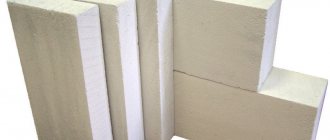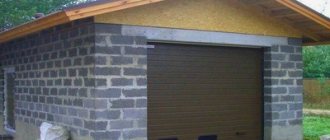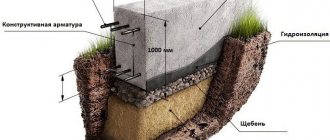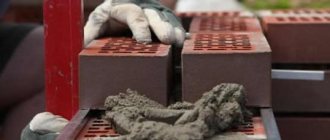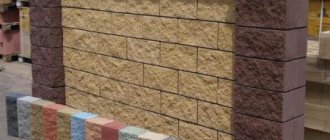Consumption rates for masonry mortar for various materials
It's no secret that construction is a rather expensive thing. In order not to purchase excess building materials, it is necessary to correctly calculate their required quantity , how much masonry mortar is required and how much materials need to be purchased.
Of course, on each package the manufacturer indicates the approximate consumption of the masonry mixture. But this indicator is influenced by a number of factors that also need to be taken into account. This includes the material from which the masonry is made, the type of mixture I use in my work, and the size of the material from which the masonry is made. For example, blocks that are placed on glue require the most minimal costs.
Bricklaying. Solution consumption
Cement mortar is still considered the most affordable masonry material. For ordinary masonry, its consumption is calculated per 1 m3. The laying of facing bricks and the costs for it are calculated per 1 m2. When calculating the required amount of solution, it is worth considering many factors. First of all, this is the size of the brick and the presence of voids in it. The larger the size of the brick, the less mortar will be required for its laying. An important factor is also the professionalism of the worker and the season in which construction work is carried out. The desired wall thickness is also taken into account. On average, the consumption of mortar per m2 of masonry with ordinary bricks (404 pieces per m3) is 75 liters of cement-sand mortar for 1 brick, 115 liters for 1.5 bricks.
It is more profitable to use thickened brick (modulated) for masonry, since mortar per m3 of masonry is required with this material.
Hollow brick is capable of absorbing mortar. In order to prevent the solution from flowing into the voids, masonry mesh is used.
Masonry mixture for bricks. Which one is suitable?
For brickwork, cement M50 and M100 is used. Typically, the masonry mixture is prepared directly at the construction site. To improve the quality of the masonry mixture, various organic and inorganic additives are added to it, on which the strength, workability and quality of concrete depend. The consumption of mortar per 1 m2 of masonry is approximately known. But how much cement is needed to prepare a masonry mixture? The calculation must be made in proportions 1:4 - 1 part binder and 4 parts filler.
Preparation of mortar for laying expanded clay concrete
To prepare the working solution, it is recommended to use a concrete mixer, which will allow you to mix all the components more efficiently. It should be noted that the amount of cement in the mixture directly affects its strength. In addition to cement, lime can be used as a binder, but such a component can be destroyed under the influence of an external aggressive environment. Regarding lime, it improves the thermal insulation properties of the mixture, so it is advisable to combine both types of binders. So, to prepare an M25 solution, you need to take one part each of lime and cement and four parts of sand.
The process for preparing the mixture is as follows. Two-thirds of the required volume of water is poured into the container of the concrete mixer, then the binders are poured in and all components are mixed until completely dissolved. After this, add sand, mix well and add the remaining water. The process of preparing the solution continues for 3-5 minutes.
Mortar consumption for brickwork
- Wholesale prices
- Delivery
- Call
- Wholesale prices
- Delivery
- Call
Count your expenses. All rates and costs are below:
How many cubes in a bag of dry cement or building mixture:
50kg - 0.038 m3
in 25kg - 0.019 m3
2. Cement-sand mortar for masonry:
For 1 m2 of brickwork with a masonry thickness of 1 brick, the amount of mortar approaches 75 liters of consumption per 1 m2. If the wall is made of brick with a thickness of 1.5 bricks, then the amount of mortar will correspond to the figure of 115 liters.
3. Proportions of cement mortar:
In order to prepare a mortar, you need: 1 part of a binder (cement) and 4 parts of filler.
4. Proportions of plaster mixture:
You will need 1 part binder (cement) and 3 parts aggregate.
5. Cement mortar for brick:
According to consumption standards, 400 pcs. bricks (more precisely 404) - 1 m3 of masonry. The solution consumption rate per 1 m3 is 0.23 m3 (in practice, 0.25 is accepted).
6. How to calculate the consumption of sand concrete M - 300 per screed?
The approximate density of the sand concrete mixture is 1.7-1.75 kg/cubic dm
For 1m/2 with a thickness of 1cm = 18-20 kg of mixture (sand concrete M300).
7. Tile adhesive:
The consumption of tile adhesive per 1 m2 of laid tiles is 10 kg. dry mixture with a layer thickness of the finished solution of 10 mm.
8. Adhesive for foam concrete blocks and gas silicate blocks:
The consumption of foam concrete adhesive per 1 m3 of laid foam concrete masonry is 40 kg. dry mixture
9. Self-leveling floors:
The consumption of self-leveling floors per 1 m2 of finished mortar is 6 kg. dry mixture, with a recommended layer thickness of 5 mm.
10. Plasters for walls:
The plaster consumption per 1 m2 of finished mortar is 10 kg. dry mixture, with a recommended layer thickness of 10 mm.
11. Wall putties:
The putty consumption per 1 m2 of finished solution is 0.9-1.0 kg. mixtures.
12. Grout (tile joints):
The grout consumption per 1 m2 of laid tiles is 120 g, with a recommended joint thickness of 2 mm.
13. Universal mixture M −150:
The consumption of the universal mixture M-150 per 1 m3 of the finished solution is 450 kg. dry mixture.
14. Masonry mixture M-200:
The consumption of the M-200 masonry mixture per 1 m3 of masonry is 350 kg. dry masonry mixture.
15. Waterproofing material (penetrating layer):
Waterproofing consumption per 1 m2 of surface will require 700 g. dry mixture diluted to a sludge state for application with a brush (roller).
16. Paints:
Paint consumption per 1 m2 of walls or ceilings when first applied to a primed, flat surface is 0.3 liters, the second layer when applied correctly is 0.2 liters per 1 m2.
17. Polyurethane floors:
The consumption of polyurethane self-leveling floor when applied to a dust-removing primer is 1.5 kg per 1 m2 of concrete floor surface, with a thickness of 1 mm.
Amount of cement per masonry (cement consumption per bricklaying):
To prepare 1 m3 of cement mortar you need 8 50 kg bags of cement. and mixed with sand in a ratio of 1:4, where one part of sand is also equal to 50 kg.
19. The consumption of materials (excluding losses) for the construction of 1 m2 of the surface of a brick wall with a thickness of a quarter of a brick is:
cement (for mortar grade M-100) - 5 kg;
cement (for mortar grade M-75) - 4 kg;
cement (for mortar grade M-50) - 2.5 kg.
How much cement, sand, crushed stone in 1 m3 of concrete (how to prepare concrete - proportions):
a) For 1m3 M 150 concrete you will need: 220 kg of cement, 0.6 m3 of sand, 0.8 m3 of crushed stone.
b) For 1m3 M 200 concrete you will need: 280 kg of cement, 0.5 m3 of sand, 0.8 m3 of crushed stone.
c) For 1m3 M 250 concrete you will need: 330 kg of cement, 0.5 m3 of sand, 0.8 m3 of crushed stone.
d) For 1m3 M 300 concrete you will need: 380 kg of cement, 0.5 m3 of sand, 0.8 m3 of crushed stone.
21. Clay-sand mortar. How to cook:
Clay-sand mortar is a 1:3 proportion, where one part clay mortar and three parts vermiculite. The resulting solution is poured in a layer up to 50 mm
To make the clay-sand mortar layer for a warm screed or wall construction even warmer, you need to mix the clay-sand mortar in a 1:1 ratio with sawdust or flooring (finely chopped straw). The prepared solution is poured into a layer 20-30 cm thick.
22. Proportion of concrete and foam chips:
In order to create such a solution, which is mainly used for insulating floors and ceilings of bathhouses, you need to mix 1 part of ordinary cement mortar (or ready-made concrete mortar) and 3 parts of foam chips.
23. How many blocks are there in 1 m3 of masonry?
Size 200×300×600 – 27 blocks per 1m3
Size 200(188)x200(188)x400 - 62 blocks per 1 m3
24. Secrets of brick or block facing masonry, masonry mortar + black seam:
Consumption - 1-1.5 buckets of solution per 1m2. Instead of an expensive plasticizer, 2 caps of cheap shampoo (for plasticity) per batch of 1/4, 1 liter. a jar of black pigment, and in order to avoid efflorescence, 200g. 9% vinegar solution.
25. Penetrating waterproofing penecrit and penetron:
Penecrete 150-200 grams per seam 25×25 mm per 1 linear meter of grooves
Penetron (for 2 layers according to technology) from 0.8 kg - 1.1 kg per 1 m2 depending on the looseness and unevenness of the surface
How many bricks are needed for 1m2 of masonry:
a) If the wall thickness is half a brick - 120 mm
- single brick - 61 pcs. excluding seam, 51 pcs. with seam
- one-and-a-half brick - 46 pcs. excluding seam, 39 pcs. with seam
- double brick - 30 pcs. excluding seam, 26 pcs. with seam
Cement consumption for bricklaying
Cement consumption per 1 m2 of brickwork directly depends on the brand of the final mortar and the initial brand of dry mixture. In any case, we recommend buying cement with a reserve, since unexpected solution costs often arise during the work. If rounding down was used during measurements or calculations, it is worth taking into account the large error in the final amount.
The consumption of cement per cubic meter of brickwork is easily calculated, but it depends on the proportion of the mortar:
- if the mixture is 1 to 3, in order to understand the amount of cement consumed, it is enough to divide 1 m3 by 4 (this is the part of the dry mixture). This turns out to be 0.25 m3 of cement per cubic meter;
- to prepare a mixture of 1 to 4, the proportion of cement will be 0.2 m3;
- if a third of lime is used as a binder, that is, the mixture turns out to be 1 part cement, 0.3 parts lime and 3 parts sand, divide 1 by 4.3 and get 0.232 m3.
The consumption of cement per cubic meter of brickwork depends on the proportion of preparation of the mortar.
Similarly, calculations of how much cement per 1 cubic meter of bricklaying are also carried out with other proportions for preparing the mixture. Cement is not calculated in cubic meters; we will have to convert the volume into weight, but this will require knowledge of the standard specific gravity (density). The brand of cement and the degree of compaction (stayed, hardened or fresh cement) have an important influence; let’s take the average number - 1300 kg/m3.
Based on the obtained value, we calculate:
- quantity of materials in a mixture of 1 to 3: 0.25 m3 * 1300 kg/m3 = 325 kg, this is how much cement is required to prepare 1 m3 of solution. To calculate how much cement is needed per 1 cubic meter of masonry, we multiply the number by the cost standard for masonry mortar. For example, we use the consumption for a single wall: 325 * 0.221 = 71.825 kg, round up to 72 kg and add an error of 75 kg. This is how much cement is needed for 1 cubic meter of masonry when using a ratio of 1 to 3;
- to prepare a 1 to 4 solution, less cement will be required. We calculate using the same algorithm: 0.2 * 1300 = 260 kg, now 260 * 0.221 = 57.46, with rounding - 58, adding the error - 60 kg of dry cement.
For convenience of calculations, the concept of a square meter of masonry is usually used. To calculate the solution consumption per 1 m2 we can use a simple formula.
Let’s not resort to calculations of the number of bricks, but rather study the legal norms and calculate the resource costs per 1 m2:
- floor bricks – 51 pcs * 0.0006305 = 0.0321 m3 of mixture per 1 m2 of masonry. We determine the amount of cement 0.0321 / 4 = 0.008025 m3 and multiply by 1300 = 10.43 kg of cement per 1 m2 of stele of 0.5 bricks;
- in brick - 102 pcs * 0.0006305 = 0.0643 m3, then 0.0643 / 4 = 0.0161 m3, now multiply by 1300 kg/m3 and get 20.9 kg of cement per 1 m2;
- 1.5 bricks - 153 pcs * 0.0006305 = 0.0965 m3 / 4 = 0.0241 m3 * 1300 kg/m3 = 31.35 kg/m2;
- in 2 bricks - 204 pcs * 0.0006305 = 0.1286 m3 / 4 = 0.03215 m3 * 1300 kg/m3 = 41.8 kg/m2.
How much cement is needed for 1000 bricks?
Brick today remains the leader among building materials used for the construction of various types of buildings. The reason for this popularity is the environmental friendliness of the material, fairly high strength, thermal insulation and many other positive qualities.
Unlike other materials, brickwork has a number of features:
- A small volume of material leads to more material being used per cubic meter, which means more consumption of concrete used.
- Varieties of brick are also leading to an increase in the use of concrete.
Before starting construction, you need to know how much cement is needed, and for this you need to understand how much mortar is needed per cubic meter of brickwork. But even if, without referring to the tables, we can confidently say that the thicker the wall, the more mortar is used, this is a truism (this takes into account vertical seams).
Composition of the solution
Brickwork consists of bricks laid in a certain order, which are connected to each other with mortar. For the solution you will need sifted sand and cement. For bricklaying, the mortar is calculated from the ratio of cement and sand (1:3).
How much cement is needed per 1000 bricks can be determined from the cement consumption per 1 m3. With a single brick laying, the cement consumption per 1000 pieces is around 8 bags, this is the maximum amount, but, as a rule, you can fit from 6 to 7 bags.
Also, how much cement is needed per 1000 bricks is influenced by the direct application of the mortar, but even with a generous application, more than 8 bags will not be needed.
Cement consumption depends slightly on:
- Like a brick.
- Like its masonry.
- Technologies for preparing the mixture.
- Direct type of bricks.
If you decide to save money and purchase a brick that was previously used, this phenomenon is natural today. But not everyone knows how to properly use such material. Such bricks should not be used for the construction of load-bearing walls, because there are many buildings in the construction of which it can be used.
How much cement is needed for 1000 used bricks? For laying such bricks, the cement consumption is no different (about 8 bags). There is nothing shameful in saving your own money, since old bricks are sometimes of much better quality than new ones. This is, of course, rare, but it does happen.
Such bricks can easily be used for structures that will not bear a heavy load. But before purchasing such a brick, you need to understand where and how you can use a used brick.
Cement consumption for brick laying
Types of cement mixture
Mortar consumption table for brickwork.
In construction, bricks are held together with a special mortar with the possible addition of impurities, such as limestone or other materials. Cement consumption for brickwork depends directly on the components of the composition. Lime batch is significantly inferior to others in strength, so it is practically not used for fastening capital structures. Cement-lime mortar is more flexible and can be used for bonding masonry. A typical cement mix consists of 3 components:
- sand;
- water;
- cement.
The strength, durability and reliability of the mixture directly depends on the quality and brand of the latter. The proportions of the components and the consumption of the cement component in laying bricks practically do not change. Most often, it is the brand that varies: for self-supporting walls it should be lower, and for load-bearing walls a higher grade is required.
To prepare 1 m3 of mixture, you need to take 8 bags of cement, 50 kg each.
Scheme of cement consumption for brick laying.
Its proportion with sand is 1:4. 1m3 of ordinary brick masonry requires 0.25-0.3 cubic meters of mixture and about 405 bricks measuring 250x120x55 mm.
This is a standard example of a mixture for permanent masonry. It may vary depending on production conditions. Thus, above-ground masonry in a wet or dry environment, as well as the construction of a foundation below the groundwater level, requires slightly different proportions. For example, the construction of external walls is best done using M10 cement mixture. For the latter you will need the M400 grade of Portland cement. For one volume fraction there are 2.1 parts of lime and 15 parts of sand.
Cement consumption rate per 1m2 of masonry
The rate of consumption of cement mortar per 1 m2 of brickwork directly depends on the thickness of the latter: the thicker the wall, the more material is required. For walls with a thickness of a quarter of a brick per 1 m2 of masonry you will need:
- 5 kg of cement in a solution of grade M100;
- 4 kg for brand M75;
- 2.5 kg for brand M50.
Brickwork diagram.
Cement mortar is consumed approximately the same for brickwork, about 300 kg per 1 m3 (0.25-0.3 cubic meters of mortar per 1 cubic meter of surface). A cement to sand ratio of 1:4 allows for optimal rigidity, mobility and adhesion. If other components are added to the batch, such as clay, limestone, marble, synthetic additives, etc., the ratio decreases down to 1:9. To prepare concrete, cement consumption should not exceed 500 kg per 1 m3. The exact characteristics of concrete are fixed by GOST, but it is allowed to change the proportions for the production of concrete to obtain certain characteristics of viscosity, density and drying time of concrete. To prepare a masonry batch, you will need the following tools:
- container for mixing and measuring (you can use a bucket or trough);
- mortar mixer or hammer drill with a mixer attachment;
- shovel.
To make a batch, dry sand and cement are first mixed, then water is gradually added in small portions. The solution should become homogeneous, solid, and not spread much. Brickwork will last longer and concrete will be stronger if the cement mixture is prepared correctly. Such designs can provide high reliability and durability.
Consumption of mortar for laying foam blocks
The required amount of mortar per cube of masonry depends on many factors (the thickness of the seam, the proportions of the mixture, the size of the building material, etc.), so it can vary up or down. Also an important factor is the thickness of the structure being built (this mainly concerns walls made of bricks and blocks).
The thicker the wall, the more concrete will be required for its laying.
Foam blocks are often used in the construction of various objects. They have relatively light weight, as well as excellent sound and noise insulation. Their dimensions significantly exceed the dimensions of bricks, therefore the consumption of masonry mixture for them will be less.
To calculate the cement consumption per cube of mortar, you need to take into account that about 0.2 m3 of mixture is spent per cube of foam blocks. Therefore, for a ratio of 1:3 per 1 m3 of masonry you will need to spend: 466.6 * 0.2 = 93.3 kg of cement, and with a ratio of 1:4 - 350 * 0.2 = 70 kg.
Return to contents
Correct calculation of mortar consumption per 1 m3 of brickwork
The first thing every self-respecting builder does before work is to carefully calculate the consumption of mortar per 1 m3 of brickwork and the cost of all materials used in the work. When building walls, it is especially important to consider the amount of mixture leaving. If the work is done poorly, cold bridges will appear in the wall, which can be dangerous to human health, since mold likes to form there. Also, such bridges can be fraught with poor heat retention, and the amount of energy required to heat the room increases.
If you calculate incorrectly, there may not be enough material or, conversely, there may be an excess amount left. A lack of materials can lead to the fact that in the midst of work you will have to go for new ones and re-make the mixture, which will slow down the process. It's better to buy everything in advance. The remaining surplus can lie unused for years and eventually deteriorate. Anyone will be sorry for the money spent, so you should calculate everything in advance. For this you will need:
- calculation calculator;
- roulette.
For each type of construction work, different mixtures are used. For brickwork, cement grades M50 or M100 are best suited.
Factors influencing the calculation of mortar consumption per 1m3 of brickwork
The most important factor affecting consumption is the type of masonry mortar used. There are four types:
- Cement-sand. This mixture is made from water, cement, sand. When applied correctly, this solution is very durable and lasts a long time without cracking.
- Limestone mixture is a solution in which quicklime acts as cement. This mixture is not suitable for external work, as it is quickly damaged by moisture.
- Mixed. When properly prepared, this solution will combine all the advantages of the two previous solutions, minimizing the disadvantages.
- Mixture with plasticizer. A special polymer additive is added to the first solution to increase its plastic properties.
To make cement-sand mortars, the strength grade of cement must be 2-3 times higher than the strength of the finished mixture (for example, for a mortar with strength M100, you need to buy cement grade M200 or M300).
Organic and inorganic additives are often added to concrete to improve its properties, mobility, and rigidity.
In addition to the type of mortar, the consumption of mortar for laying bricks also depends on the materials, sizes and properties of the brick itself. The thicker the wall, the greater the consumption. If the brick is not solid, but hollow, more mixture will also be consumed.
Consumption per cubic meter
- for half (120×120×65) it will be 0.189 m3;
- for single (250×120×65) it will be 0.221 m3;
- for one and a half (380 × 120 × 65) it will be 0.234 m3;
- for double (510x120x65) it will be 0.240 m3;
- for double and a half (640x120x65) it will be 0.245 m3.
Thus, one solid brick requires about 0.0006305 m3 of mortar. Therefore, for 1 m2 of brickwork with a width of 120 mm, about 75 liters of mixture will be required.
For modulated bricks (250x120x88) the consumption will be slightly less:
- for half (120x120x88) it will be 0.160 m³;
- for a single (250x120x88) it will be 0.20 m3;
- for one and a half (380x120x88) it will be 0.216 m3;
- for double (510x120x88) it will be 0.222 m3;
- for double and a half (640x120x88) it will be 0.227 m3.
For hollow bricks, the mortar consumption per 1 m2 of masonry will be higher.
To calculate the solution, it is necessary to calculate the total footage of the construction area and multiply it by the consumption per 1 cubic meter.
Cement consumption
After calculating the required amount of the mixture, it remains to find out how much and what brand of cement should be purchased. At the same time, it is always better to buy cement “with a reserve” - in case of unexpected consumption or a large error in the calculations.
Exact consumption of mortar for brickwork
So that after construction work you do not have any excess building material left, you need to calculate the quantity in advance with a small margin. It is necessary to take into account that over time, not all building mixtures will be able to maintain their characteristics. For example, sand can remain the same crumbly after a few months, and cement, if stored improperly, can turn from a fine powder into a large stone. To avoid such troubles, and especially unnecessary waste of money, you must not only correctly calculate the materials for the masonry, but also calculate the amount of all the necessary materials for other work, if any, for example, screeding walls, plastering, pouring the foundation.
So that after completing the bricklaying work you are not left with excess material, you need to calculate the amount of material you will need before starting work.
In order to calculate everything, you need to have:
- Calculator.
- Ruler or tape measure.
Before you start calculating building materials for brickwork, you must decide on the brand of cement, which must correspond to the type and volume of work you plan to carry out.
It is important to know: different construction jobs require different types of mortars.
You cannot use one solution for all construction work. Each process requires the preparation of a separate solution.
It is impossible to perform all the necessary construction work with one solution. For example, sand-cement, concrete, slag-cement mortars will have different strengths, and their strength will directly depend on the brand, while the manufacturer’s brand does not play a big role.
It is important to remember that its durability will depend on the strength of your building. For example, if you are sure that you are using durable, high-quality, purified material, then you will not have to worry about your building; for example, various precipitation will not damage it, which means the building will last longer.
Which cement is better to use?
M50 or M100 is best suited for brickwork.
For bricklaying, the best grades are M100 and M50.
To make your own mortar, you need to prepare the appropriate composition from strictly dosed various components. To make concrete of better quality, various organic additives are added - marble, sand, clinker, crushed stone, as well as various inorganic additives. Inorganic additives are synthetic substances. The rigidity, mobility, and adhesion of concrete will depend on how many different additives are added.
Calculation of the required quantity
For each square meter you will need approximately 0.2 - 0.25 cubic meters of solution.
For every sq. m you will need 0.2 - 0.25 cubic meters. m.
To calculate how much consumption will go per sq. m need to calculate how many square meters the building is. Please note that with a building thickness of 1 brick, approximately 75 liters are needed. If the thickness is 1.5 bricks, then the consumption is approximately 115 liters.
For one sq. m, if the wall thickness is a quarter of a brick (excluding losses), we will need:
- Brand M100 – 5 kg.
- Brand M75 – 4 kg.
- Brand M50 – 2.5 kg.
In this case, the proportions should be calculated as 1:4, i.e. 1 part binder and 4 parts filler. For example, to prepare a solution for 1 cubic meter. It will take 8 bags of 50 kg, one part of sand is equal to 50 kg. To prepare a strong mixture, cold, purified water (up to +20 degrees Celsius) is usually used.
Sand is used as a filler; the grain size should be no more than 2.5 mm. We should not forget that before mixing everything, the sand must be sifted to remove debris, stones and shells.
Calculation of mortar and bricks per 1 cubic meter:
For one cubic meter of wall you will need about 400 pieces. bricks, but it is better to take 10 pcs. The consumption rate is considered to be 0.23 m3 per 1 cubic meter, but professional builders often use 0.25.
The consumption of masonry mortar depends on many details that must be taken into account. Often, lazy builders, to make their work easier, use hollow bricks, which have depressions and cells, instead of regular material. By doing this, they increase the consumption of mortar. Other types of bricks will have a completely different consumption, because using familiar building materials, such as modular or silicate, you will not have to fill the cavities and cells with additional mortar.
For example, if you take hollow material for laying a new wall, given that the thickness of this wall will be 1.5 bricks, then for 1 cubic meter of masonry you will need 395-400 bricks, which is 0.23 cubic meters, and if you build the same wall, but use silicate or modular material, then it will take 0.21 cubic meters.

